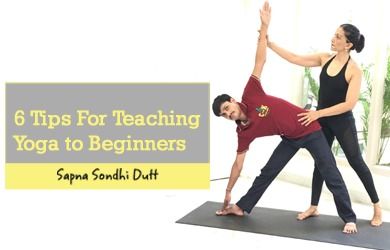Teaching yoga to beginners may sound like an easy prospect as the poses one will be teaching the students will be the most basic and simple, ones. In reality, though, this is a huge challenge. Advanced practitioners know exactly what they are doing. They are familiar with their postures, correct alignment, the complicated yoga terms, and everything else associated with their yoga routines. On the other hand, beginners usually enter the class being nervous and unsure of what to expect. Often, one will find them with eyes wide in anticipation, as they wait for class to begin.
Beginners will rely on the teacher’s guidance the most. Hence, it is the teacher’s job to make it as easy, comfortable, fun, and relaxing as possible for them. This is where the challenge lies. To be effective, knowing one’s poses perfectly is crucial so that one can communicate the steps in the simplest way possible.
A teacher is required to know variations in postures that will help students to attempt them, as many of them begin their yoga practice with minimum flexibility. Having said that, it will be equally rewarding for the teacher as he or she gains experience through each student’s yoga journey.
Now, here are a few tips that yoga teachers should keep in mind with a class of beginners.
Keep it Simple and Focussed
It is natural that when a person is learning a new skill, too much information can get overwhelming. When you are teaching a class full of beginners, your main goal is to establish a foundation by acquainting them with the basics. Concentrate on timing, breathing, and alignment.
A classic path to choose is to guide them through the basic steps of the posture or an appropriate variation of the same. Once students are familiar with the pose, you can move on to alignment cues.
Avoid suggesting too many alignment tips. Observe the students’ pose and suggest basic tips that will make it safe and comfortable for them. For instance, in a forward bending pose such as ‘Paschimottanasana’, beginners might attempt to lead the posture with their faces rather than bending down from their hips with a flat back. So, the correct alignment would be to explain them to maintain the length of the spine as they fold forward. For beginners, a simple alignment tip like this goes a long way in ensuring a safely executed posture.
Do Away With The Jargons
The terminology and the language you use should be such that that even non yogis understand. While explaining the pose, narrate the steps in simple language. Use straightforward words such as “lift”, “bend”, “turn” and “stretch”.
You can’t expect students to know yogic terms like the “Jalandhara Bandha” or the “Prana Mudra”. This applies to names of the poses as well, especially their Sanskrit counterparts. When you use these terms make sure you define them for your audience.
Adhere To a Sequence
Creating a sequence is especially important for a class of beginners. Have a class outline ready with you well in advance. Penning down an outline will help you internalize whatever you intend to teach. . It is better to time your poses, so that you do not overshoot the class duration.
Introduce some new postures in each class while keeping one or two sequences consistent across all future classes Since your students are beginners, repetition will help them in continuously improve in their asanas. Maintaining this consistency will also help them attempt their postures with a level of relaxation.
Get To Know Your Audience
Your approach to teaching the class depends on your audience. Every class and then within the class every person will be different. We, as teachers need to understand that, and then even within the same class we can challenge each student differently. Sometimes it could be a class of professionals who want to relax after a hard day at work, or it could be a class of students at a school.
It’s a good idea to ask relevant questions to understand their expectations and challenges. Reserve time to have short dialogues with them. Make your questions as specific as possible to get students talking. Encourage them to clarify their doubts or queries, if any.
Encourage Students To Focus On Themselves
Before your session begins, help your class participants relax and let of go of the expectation of getting it right. Anyone new to the practice of yoga cannot have their alignment and postures pat. Often, the attention of new students wanders towards what others around them are doing.
It is a natural reaction and there is nothing wrong with observing others for inspiration. However, it takes away the focus from their own self. Give individual attention to each of them before and after class and remind them constantly to be relaxed during the practice. .
Make Transitions Easy
Transitioning from one pose to another does not come easy, especially for new students. This can be pretty frustrating for students, often even for advanced practitioners. While introducing poses to beginners, make sure to keep the transitions simple. For instance, during the Sun Salutation, when lowering down from Downward Dogto “Salute with eight limbs” (ashtanga namaskaar), where our chin, chest, and hands and toes are in contact with the floor, we can make it easier by asking students to first come down flat on the floor and then scoot their hips up to assume the final posture. .
Conclusion
Teaching a class of beginners is a great opportunity to polish your skills as a teacher. Breaking down poses to elaborate each step, answering queries, explaining jargons, catering to individual needs of students and working with their limitations would require you to be really confident and thorough with your own knowledge of yoga asanas and the human body anatomy.
You have this challenging task of introducing another human being to this wonderful, transformative, and healing practice of yoga. So discharge this challenge, responsibly.
